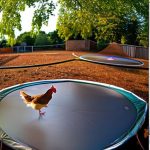Peacocks and chickens are domesticated birds commonly kept for ornamental and practical purposes. Peacocks, a type of pheasant native to South Asia, are renowned for their vibrant, colorful plumage and distinctive fan-like displays during courtship. They are known for their loud, distinctive calls.
Chickens, domesticated fowl raised primarily for eggs and meat, come in various breeds and colors. They are generally more docile and less vocal than peacocks, and are valued for their egg production, meat, and pest control abilities. Despite their differences, peacocks and chickens can coexist successfully in the same environment when provided with appropriate care and accommodations.
Peacocks require more space and specialized care due to their larger size and unique needs, while chickens are generally easier to maintain and more adaptable to various living conditions. Understanding the distinct characteristics and requirements of both species is crucial for their successful cohabitation and care. Factors such as adequate space, proper nutrition, and appropriate housing must be considered when keeping peacocks and chickens together.
With proper management, these two bird species can thrive in a shared environment, offering both aesthetic appeal and practical benefits to their keepers.
Table of Contents
Key Takeaways
- Peacocks and chickens are both popular poultry species, but they have different characteristics and requirements.
- Peacocks and chickens can be compatible if introduced properly and given enough space to coexist.
- Both peacocks and chickens require adequate housing and space to roam, with peacocks needing more vertical space.
- Peacocks and chickens have different dietary needs, with peacocks requiring a higher protein diet.
- Both peacocks and chickens are susceptible to certain diseases and health issues, so regular monitoring and care is essential.
Compatibility of Peacocks and Chickens
Coexistence is Possible
Peacocks and chickens can live together peacefully in the same environment, but it’s crucial to consider several factors when introducing them to each other. While peacocks can be territorial and display aggressive behavior towards other birds, including chickens, proper introductions and adequate space can help them learn to tolerate each other’s presence and even form social bonds.
Key Considerations for a Harmonious Coexistence
When introducing peacocks and chickens, it’s essential to provide enough space for both species to establish their own territories and avoid conflicts. Close monitoring of their interactions is also vital to ensure that no aggressive behavior occurs. Additionally, providing multiple feeding and watering stations can help reduce competition and minimize potential conflicts between the two species.
Benefits of Coexistence
With careful planning and supervision, peacocks and chickens can coexist harmoniously and even benefit from each other’s company. By following these guidelines, you can create a peaceful and thriving environment for both species to thrive.
Housing and Space Requirements

Peacocks and chickens have different housing and space requirements due to their unique behaviors and physical characteristics. Peacocks are larger and more active birds compared to chickens, requiring more space to roam and display their natural behaviors. They also need elevated roosting areas to perch on at night, as well as shelter from the elements.
On the other hand, chickens are smaller and more adaptable to confined spaces, but they still require adequate room to move around and access nesting boxes for laying eggs. When housing peacocks and chickens together, it is important to provide separate areas for each species to roost and nest. This can help prevent territorial disputes and ensure that both birds have access to the resources they need.
Additionally, providing ample outdoor space for foraging and dust bathing is essential for both peacocks and chickens to maintain their physical and mental well-being. Overall, providing a spacious and well-designed coop and outdoor area is crucial for the successful cohabitation of peacocks and chickens.
Feeding and Nutrition
Peacocks and chickens have different dietary needs and preferences, requiring careful consideration when feeding them in the same environment. Peacocks are omnivorous birds that consume a varied diet consisting of insects, small mammals, fruits, seeds, and vegetation. They also require higher protein levels compared to chickens, especially during the breeding season.
Chickens, on the other hand, are omnivores that primarily consume grains, seeds, insects, and kitchen scraps. They also require access to grit for digestion and calcium supplements for egg production. When feeding peacocks and chickens together, it is important to provide a balanced diet that meets the nutritional requirements of both species.
This may involve offering a combination of commercial poultry feed, fresh fruits and vegetables, mealworms, and other protein-rich treats. Additionally, providing separate feeding stations for peacocks and chickens can help prevent competition and ensure that each bird receives an adequate amount of food. Overall, understanding the dietary needs of peacocks and chickens is essential for maintaining their health and well-being in a shared environment.
Health and Disease Considerations
Peacocks and chickens are susceptible to different health issues and diseases that require careful monitoring and preventative measures. Peacocks are prone to respiratory infections, parasites, and injuries from aggressive behavior or environmental hazards. Chickens are susceptible to a wide range of diseases such as coccidiosis, Marek’s disease, avian influenza, and external parasites like mites and lice.
When housed together, it is important to implement biosecurity measures to prevent the spread of diseases between peacocks and chickens. Regular health checks, vaccinations, parasite control, and proper sanitation practices are essential for maintaining the health of both peacocks and chickens in a shared environment. Providing access to clean water, nutritious food, shelter from extreme weather conditions, and adequate space for exercise can also help boost their immune systems and overall well-being.
Additionally, observing their behavior and appearance on a daily basis can help detect any signs of illness or distress early on. Overall, proactive health management is crucial for ensuring the well-being of peacocks and chickens living together.
Behavioral Considerations

Understanding Peacock Behavior
Peacocks are known for their elaborate courtship displays, vocalizations, and territorial behaviors during the breeding season. They may also exhibit aggressive behavior towards other birds when establishing dominance or defending their territory.
Chickens, on the other hand, have a more structured social hierarchy within their flock, with established pecking orders that can lead to aggression or bullying among individuals.
Creating a Harmonious Environment
Understanding the natural behaviors of peacocks and chickens is essential for creating a harmonious living environment for both species. Providing enough space for each bird to establish their own territories, as well as offering enrichment activities such as perches, dust bathing areas, and hiding spots can help reduce stress and prevent aggressive behaviors. Additionally, providing multiple feeding stations and nesting boxes can help minimize competition and promote peaceful cohabitation. Overall, creating a supportive environment that meets the behavioral needs of both peacocks and chickens is essential for their overall well-being.
Conclusion and Recommendations
In conclusion, peacocks and chickens can coexist harmoniously when provided with proper care, accommodations, and supervision. Understanding the unique characteristics, requirements, behaviors, and nutritional needs of both species is essential for successful cohabitation. Providing adequate housing space, balanced nutrition, proactive health management, and behavioral enrichment activities can help create a supportive environment for peacocks and chickens living together.
When considering housing peacocks and chickens together, it is important to carefully plan their introduction, monitor their interactions closely, provide separate living areas within the same environment, offer a balanced diet that meets their nutritional needs, implement biosecurity measures to prevent disease transmission, and create an enriching environment that supports their natural behaviors. By following these recommendations, peacocks and chickens can thrive in a shared environment while providing companionship, pest control benefits, ornamental value, eggs, or meat for their caretakers.
If you’re considering keeping peacocks and chickens together, you may also be interested in learning about the benefits of using an A-frame chicken coop. This type of coop, as discussed in this article, provides a secure and spacious environment for your chickens to thrive while also allowing for easy access for cleaning and maintenance. It’s important to consider the housing and living arrangements for all of your poultry to ensure they can coexist peacefully.
FAQs
Can peacocks and chickens be kept together?
Yes, peacocks and chickens can be kept together in the same coop or living space.
Are there any special considerations for keeping peacocks and chickens together?
It is important to provide enough space for both peacocks and chickens to roam and forage. Additionally, peacocks may be more aggressive than chickens, so it is important to monitor their interactions and provide separate feeding areas if necessary.
What do peacocks and chickens eat?
Both peacocks and chickens are omnivores and can eat a similar diet of grains, seeds, insects, and small animals.
Do peacocks and chickens require different housing?
While peacocks and chickens can be housed together, peacocks may require higher perches and larger roosting areas due to their larger size and ability to fly.
Do peacocks and chickens get along well together?
In general, peacocks and chickens can coexist peacefully, but it is important to monitor their interactions and provide enough space and resources for both species.
Meet Walter, the feathered-friend fanatic of Florida! Nestled in the sunshine state, Walter struts through life with his feathered companions, clucking his way to happiness. With a coop that’s fancier than a five-star hotel, he’s the Don Juan of the chicken world. When he’s not teaching his hens to do the cha-cha, you’ll find him in a heated debate with his prized rooster, Sir Clucks-a-Lot. Walter’s poultry passion is no yolk; he’s the sunny-side-up guy you never knew you needed in your flock of friends!







